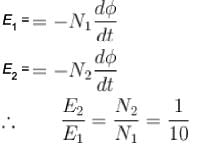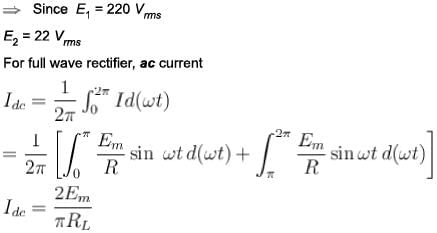Physics Exam > Physics Questions > An ac voltage of 220 Vrms is applied to the p...
Start Learning for Free
An ac voltage of 220 Vrms is applied to the primary of a 10:1 step-down transformer. The secondary of the transformer is centre tapped and connected to a full-wave rectifier with a load resistance. This dc voltage appearing in the load is.
- a)44/π
- b)31/π
- c)62/π
- d)22/π
Correct answer is option 'A'. Can you explain this answer?
| FREE This question is part of | Download PDF Attempt this Test |
Verified Answer
An ac voltage of 220 Vrms is applied to the primary of a 10:1 step-dow...
For step-down transformer,
E < E1


(44/π)
E < E1


(44/π)
Most Upvoted Answer
An ac voltage of 220 Vrms is applied to the primary of a 10:1 step-dow...
To find the DC voltage appearing in the load, we need to consider the voltage transformation ratio of the transformer and the rectification process.
Given:
AC voltage applied to the primary of the transformer = 220 Vrms
Step-down transformer ratio = 10:1
The secondary voltage of the transformer can be calculated using the transformation ratio:
Secondary voltage = Primary voltage / Transformation ratio
Secondary voltage = 220 Vrms / 10
Secondary voltage = 22 Vrms
Since the secondary is center-tapped, we have two equal halves of the secondary voltage.
Now, let's consider the full-wave rectification process. In a full-wave rectifier, the output voltage is the absolute value of the input voltage. So, the negative half of the voltage is flipped to become positive.
So, the peak voltage of the rectified waveform is equal to the peak voltage of the secondary voltage.
Peak voltage = Secondary voltage = 22 Vrms
To find the DC voltage, we need to convert the peak voltage to the average voltage by multiplying it by 0.637 (the peak-to-average conversion factor for a full-wave rectifier).
Average voltage = Peak voltage * 0.637
Average voltage = 22 V * 0.637
Average voltage ≈ 14.014 V
Therefore, the DC voltage appearing in the load is approximately 14.014 V.
Given:
AC voltage applied to the primary of the transformer = 220 Vrms
Step-down transformer ratio = 10:1
The secondary voltage of the transformer can be calculated using the transformation ratio:
Secondary voltage = Primary voltage / Transformation ratio
Secondary voltage = 220 Vrms / 10
Secondary voltage = 22 Vrms
Since the secondary is center-tapped, we have two equal halves of the secondary voltage.
Now, let's consider the full-wave rectification process. In a full-wave rectifier, the output voltage is the absolute value of the input voltage. So, the negative half of the voltage is flipped to become positive.
So, the peak voltage of the rectified waveform is equal to the peak voltage of the secondary voltage.
Peak voltage = Secondary voltage = 22 Vrms
To find the DC voltage, we need to convert the peak voltage to the average voltage by multiplying it by 0.637 (the peak-to-average conversion factor for a full-wave rectifier).
Average voltage = Peak voltage * 0.637
Average voltage = 22 V * 0.637
Average voltage ≈ 14.014 V
Therefore, the DC voltage appearing in the load is approximately 14.014 V.
Free Test
FREE
| Start Free Test |
Community Answer
An ac voltage of 220 Vrms is applied to the primary of a 10:1 step-dow...
Correct answer is option (c)

|
Explore Courses for Physics exam
|

|
Similar Physics Doubts
An ac voltage of 220 Vrms is applied to the primary of a 10:1 step-down transformer. The secondary of the transformer is centre tapped and connected to a full-wave rectifier with a load resistance. This dc voltage appearing in the load is.a)44/πb)31/πc)62/πd)22/πCorrect answer is option 'A'. Can you explain this answer?
Question Description
An ac voltage of 220 Vrms is applied to the primary of a 10:1 step-down transformer. The secondary of the transformer is centre tapped and connected to a full-wave rectifier with a load resistance. This dc voltage appearing in the load is.a)44/πb)31/πc)62/πd)22/πCorrect answer is option 'A'. Can you explain this answer? for Physics 2024 is part of Physics preparation. The Question and answers have been prepared according to the Physics exam syllabus. Information about An ac voltage of 220 Vrms is applied to the primary of a 10:1 step-down transformer. The secondary of the transformer is centre tapped and connected to a full-wave rectifier with a load resistance. This dc voltage appearing in the load is.a)44/πb)31/πc)62/πd)22/πCorrect answer is option 'A'. Can you explain this answer? covers all topics & solutions for Physics 2024 Exam. Find important definitions, questions, meanings, examples, exercises and tests below for An ac voltage of 220 Vrms is applied to the primary of a 10:1 step-down transformer. The secondary of the transformer is centre tapped and connected to a full-wave rectifier with a load resistance. This dc voltage appearing in the load is.a)44/πb)31/πc)62/πd)22/πCorrect answer is option 'A'. Can you explain this answer?.
An ac voltage of 220 Vrms is applied to the primary of a 10:1 step-down transformer. The secondary of the transformer is centre tapped and connected to a full-wave rectifier with a load resistance. This dc voltage appearing in the load is.a)44/πb)31/πc)62/πd)22/πCorrect answer is option 'A'. Can you explain this answer? for Physics 2024 is part of Physics preparation. The Question and answers have been prepared according to the Physics exam syllabus. Information about An ac voltage of 220 Vrms is applied to the primary of a 10:1 step-down transformer. The secondary of the transformer is centre tapped and connected to a full-wave rectifier with a load resistance. This dc voltage appearing in the load is.a)44/πb)31/πc)62/πd)22/πCorrect answer is option 'A'. Can you explain this answer? covers all topics & solutions for Physics 2024 Exam. Find important definitions, questions, meanings, examples, exercises and tests below for An ac voltage of 220 Vrms is applied to the primary of a 10:1 step-down transformer. The secondary of the transformer is centre tapped and connected to a full-wave rectifier with a load resistance. This dc voltage appearing in the load is.a)44/πb)31/πc)62/πd)22/πCorrect answer is option 'A'. Can you explain this answer?.
Solutions for An ac voltage of 220 Vrms is applied to the primary of a 10:1 step-down transformer. The secondary of the transformer is centre tapped and connected to a full-wave rectifier with a load resistance. This dc voltage appearing in the load is.a)44/πb)31/πc)62/πd)22/πCorrect answer is option 'A'. Can you explain this answer? in English & in Hindi are available as part of our courses for Physics.
Download more important topics, notes, lectures and mock test series for Physics Exam by signing up for free.
Here you can find the meaning of An ac voltage of 220 Vrms is applied to the primary of a 10:1 step-down transformer. The secondary of the transformer is centre tapped and connected to a full-wave rectifier with a load resistance. This dc voltage appearing in the load is.a)44/πb)31/πc)62/πd)22/πCorrect answer is option 'A'. Can you explain this answer? defined & explained in the simplest way possible. Besides giving the explanation of
An ac voltage of 220 Vrms is applied to the primary of a 10:1 step-down transformer. The secondary of the transformer is centre tapped and connected to a full-wave rectifier with a load resistance. This dc voltage appearing in the load is.a)44/πb)31/πc)62/πd)22/πCorrect answer is option 'A'. Can you explain this answer?, a detailed solution for An ac voltage of 220 Vrms is applied to the primary of a 10:1 step-down transformer. The secondary of the transformer is centre tapped and connected to a full-wave rectifier with a load resistance. This dc voltage appearing in the load is.a)44/πb)31/πc)62/πd)22/πCorrect answer is option 'A'. Can you explain this answer? has been provided alongside types of An ac voltage of 220 Vrms is applied to the primary of a 10:1 step-down transformer. The secondary of the transformer is centre tapped and connected to a full-wave rectifier with a load resistance. This dc voltage appearing in the load is.a)44/πb)31/πc)62/πd)22/πCorrect answer is option 'A'. Can you explain this answer? theory, EduRev gives you an
ample number of questions to practice An ac voltage of 220 Vrms is applied to the primary of a 10:1 step-down transformer. The secondary of the transformer is centre tapped and connected to a full-wave rectifier with a load resistance. This dc voltage appearing in the load is.a)44/πb)31/πc)62/πd)22/πCorrect answer is option 'A'. Can you explain this answer? tests, examples and also practice Physics tests.

|
Explore Courses for Physics exam
|

|
Suggested Free Tests
Signup for Free!
Signup to see your scores go up within 7 days! Learn & Practice with 1000+ FREE Notes, Videos & Tests.


















